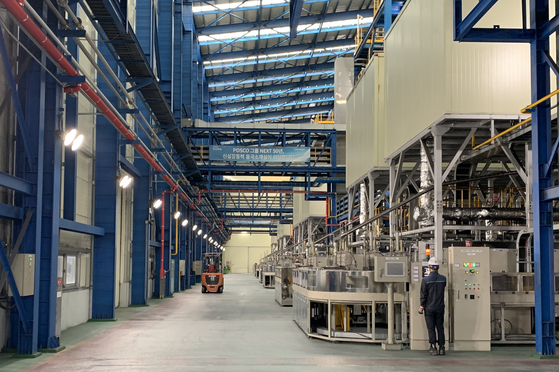![Inside the POSCO Chemical anode material factory in Sejong City. The natural graphite surface treatment process is carried out in a 5-story building height facility. [사진 포스코케미칼]](https://i0.wp.com/pds.joins.com/news/component/htmlphoto_mmdata/202103/04/7b8cd5b5-467d-4918-8a9f-22f8db1e802d.jpg?w=560&ssl=1)
Inside the POSCO Chemical anode material factory in Sejong City. The natural graphite surface treatment process is carried out in a 5-story building height facility. [사진 포스코케미칼]
“Posco is metallic, but cutting-edge battery materials are also in front of the world’s top.”
Sejong POSCO Chemical Anode Material 2nd Factory Report
Core material for secondary battery made of graphite
Just by looking at the structure, the process is exposed, so the security is thorough.
Beyond Japan in 10 years of new growth investment
China’s Big 3 onslaught, sales of 23 trillion in 2030
POSCO Chemical’s anode material 2 factory located in Sejong City’s high-tech industrial complex on the 23rd. When entering about 100m from the factory entrance, the kiln (the process of baking graphite) was busy turning the conveyor belt. “It is the first time that an outsider has entered this place since last year’s factory operation,” said Kyu-yong, head of POSCO Chemical’s anode material division. “The manufacturing of negative electrode materials contains technology and know-how in the process of coating and firing natural graphite, which is a raw material,” he said. “The facility itself is a trade secret.” He said, “If you are a person in the related industry, just looking at the structure (POSCO Chemical’s) process can be exposed, so we are doing thorough security.”
144% increase in sales in the energy materials sector last year
![On the 23rd of last month, Jeong-Yong POSCO Chemical's anode material mounting (left) explains the process of sintering natural graphite. [사진 포스코케미칼]](https://i0.wp.com/pds.joins.com/news/component/htmlphoto_mmdata/202103/04/625a70d1-44f9-4641-acf2-51c0941f7f29.jpg?w=560&ssl=1)
On the 23rd of last month, Jeong-Yong POSCO Chemical’s anode material mounting (left) explains the process of sintering natural graphite. [사진 포스코케미칼]
POSCO, which used to melt metal to make iron, is on the verge of becoming the top in the field of anode materials, a key material for electric vehicle batteries, which is a new growth field in the future. POSCO occupied 11% of the global anode material market last year, surpassing Japan’s Mitsubishi and Hitachi, ranking fourth in the global market. POSCO is now closely following China’s BTR, Shanshan, and Zichun, which are the first to third-largest producers. This is the achievement achieved only 10 years after POSCO entered the natural graphite anode material market in 2010, the only Korean company.
Since the 2000s, POSCO has selected secondary battery materials as a future new growth industry, and has devoted all efforts to investment and technology development. In the transition period in which the automobile industry shifted from internal combustion locomotives to electric vehicles, the automotive material business was expanded from steel plates to batteries. Following the merger of POSCO Chemtech and POSCO ESM into POSCO Chemical in 2019, it decided to increase capital increase of 1.273.5 billion won at the end of last year to raise investment resources. Investment led to achievements, and sales in the energy materials sector last year increased by 144% from the previous year to 533.3 billion won. By 2030, it aims to generate 23 trillion won in sales only in the energy materials sector.

Electric car and negative/positive electrode sales forecast
In the anode material field, the gap between POSCO and China is the difference in scale. “The production volume is after China, but we are ahead of the technology and production capacity per unit of equipment, including dry coating patents. China has quite a few human intervention processes, but POSCO Chemical has all the processes automated.” Said. In fact, only two workers were visible in the 6000m2 plant. There are only 40 people who manage and control the factory with 10 people per shift and in 24-hour shifts.
Graphite is widely used as a raw material for negative electrode material, one of the four lithium-ion battery materials (positive electrode material, negative electrode material, electrolyte, and separator). If the positive electrode material generates electricity through a chemical reaction of a lithium ion source to charge the battery, the negative electrode material generates electricity by trapping lithium ions between fine graphite particles and releasing them when the battery is used. As for the anode material that influences the battery life, the technology for dealing with graphite is the key.
POSCO Chemical’s anode material 2 plant had eight kilns. As a rule, fine graphite particles that have been surface-treated in a five-story facility connected by hundreds of pipes are finally reborn as a negative electrode material through firing. However, I looked around the process for about 20 minutes, but all I could see was that the black graphite powder was put in an iron box and went on a conveyor belt. “It is difficult to identify with the eyes because 10 micrometers (μm, 1 micrometer is 1 millionth of a meter) fine particles are operated through high-tech facilities,” said Jeong. “It is not visible, but graphite is round to store a lot of lithium. It has a shape,” he said.
“Like steel, K-battery will support growth”
POSCO Chemical is building a 2-2 plant right next to the anode material 2 plant. Plant 2-2 has eight kiln furnaces like Plant 2, but the production per unit area has been increased by further upgrading the process. The combined production scale of the three is 69,000 tons. POSCO Chemical plans to enter the field of artificial graphite and silicon-based anode materials in the future as well as natural graphite to have a production scale of 260,000 tons by 2030. “Three Korean battery companies are leading the global secondary battery market, so the material sector is expected to grow with it.” “As steel supported the growth of the Korean automobile industry, it will play a role in the battery material field.” Said.
Reporter Kim Young-joo [email protected]
![]()
